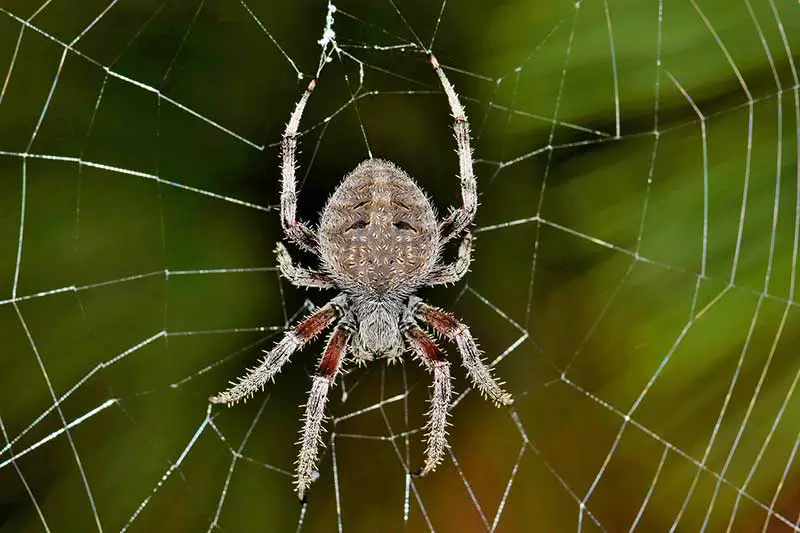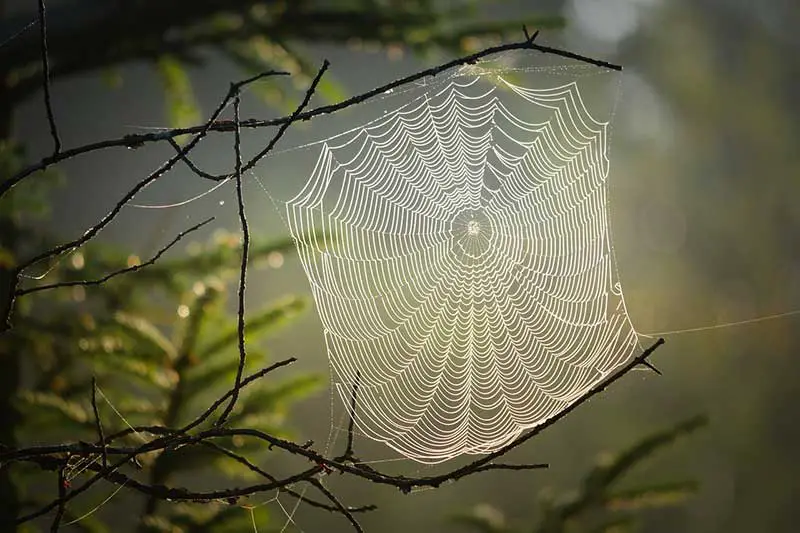How to Do Spider Web Out of Beef Netting
Spiders are fascinating creatures. They are primary spinners, architects, and structural engineers all rolled into each tiny eight-legged body. However, most humans have an inherent fear of spiders. At Halloween, fake spider webs are frequently incorporated in scary décor. It makes you wonder, how do spiders really make webs? That's what nosotros'll discuss in this commodity.
If you lot have ever accidentally walked through a existent spider web, yous know the feeling of panic and sudden improvised karate moves to get information technology off. But in reality, each spider web is a tiny masterpiece that should fill us with wonder at these incredible arachnids.
How Practice Spiders Make Webs?
Spiders make webs using a silk thread that is excreted by the spinneret. The spider controls the thread'southward thickness, texture, and adhesiveness equally it'south fatigued from the spinneret depending on the thread'southward intended purpose. Well-nigh spiders have three spinnerets, some up to 8, for unlike thread sizes.
Spiders are special in their ability to produce silk. The silk, which is in a liquid form, is excreted from an organ chosen a spinneret, located at the rear base of the abdomen.
A spider's spinneret is amazing equally it allows the spider to decide the thickness of the silk required, if it should be sticky or non, and if the thread should be smooth or rough.
The silk starts as a liquid but dries and solidifies when exposed to air.
Like a internet, the edges of the spider web are anchored onto strategic points to hold the net open up and taught; these are known equally frame threads. Once the external frame threads and anchor points accept been established, the spider fills the void betwixt the frame with radial and viscid threads.
Radial webs run from the center to the edge, while the lateral threads are called the pasty threads. Mooring threads may also class part of the spider web. These are the long threads you may see extending out from the web onto an anchoring point.
The spider excretes the silk strands as it crawls along in a unique pattern that so forms the spider web'south elaborate design. Each thread is precisely placed to maximize the take chances of communicable an insect in the net.
This video shows a Garden Orb Web Spider building a web, wonderfully recorded in time-lapse by BBC Earth.
Why Exercise Spiders Build Webs?
Spiders build elaborate webs to trap insects that the spiders eat. The spider webs silk fibers are coated with a viscous substance that prevents an insect from escaping one time it has flown into the web. When the insect struggles when trying to free itself, the insect becomes entangled in the spider web itself.
Spider webs, also known as cobwebs, are a great way of communicable food without the spider needing to run after and take hold of the prey animate being physically.
The spider lies in wait in the middle of the spider web for piece of cake and fast access to the prey item when it lands in the web.
A swift bite from the spider injects venom into the insect; this quickly kills or paralyzes the victim and allows the spider to bask the insect at leisure.
Do All Spiders Make Webs?
Non all spiders build spider webs equally we know them. Some spiders are ground-dwelling and lie in look for an unsuspecting insect to laissez passer past before grabbing it.
Other spiders behave a small net or spider web along with them. The spider web is tossed over its unsuspecting prey to take hold of the casualty.
How Strong Is A Spider'southward Web?
The private strands of a spider's web are incredibly strong. Size for size, the silk is far stronger than steel.
The web design combined with the strong silk threads makes information technology very hard for an insect to break out of a web once caught.
Practise Spiders Eat Their Spider Web?
Many spiders practise swallow their spider webs. Spider webs lose their stickiness over time which makes them less effective in capturing food for the spider.
Ingeniously, the spider recycles its spider web by eating it. The silk thread from which the spider web is made has a very loftier protein content.

Are All Web Designs Like?
Non all spider webs await the same, but most share basic pattern principles without which the web would not have its characteristic shape.
Of course, spider webs are plant in many locations, both in homes or out in the wild. In that location are roughly forty-8 thousand spider species in the earth, so web designs vary widely.
Usually plant on all spider webs are the following silk threads that help in creating the spider web.
- Mooring threads – Long threads that adhere to the frame threads and act as the main anchor lines.
- Frame threads – Create a frame around the web to which the inner threads are fastened.
- Radial Threads – Threads run from the center of the spider web to the exterior, attached to the frame threads
- Sticky threads – Too called the orb threads, are the thin threads that run between the radial threads and are glutinous to trap the insects.
Are Spider Webs Sticky?
The silk threads of a spider'south spider web are covered with glutinous droplets that the spider produces in a gland in its stomach. But the very fine threads, chosen viscid threads, are sticky and designed to entrap insects that spiders swallow.
The glue-coated gluey threads of a spider's spider web are almost a 3rd of the diameter of a human hair. The spider webs silk threads are flexible, making it very difficult for the prey insect to go leverage to free itself. The more than the insect struggles, the more information technology invariably gets tangled in the web.

Spiders know which strands of the web are coated with the glue and then avoid stepping on them to avert being trapped by the spider'southward web.
Tin can Spiders Run Out Of Spider web
Spiders secrete the silk from which spider webs are made from their spinneret. The spider produces its silk which is very loftier in protein. A spider can run out of web if the spider is in poor condition. Not having fed for a long time, injured or very old, would drain its actual reserves.
Under normal conditions, the spider tin produce sufficient silk from reserves built upwardly in its trunk to complete the spider web that the spider is building.
In the case where the spider has simply completed the new spider web, and the spider web is destroyed, the spider may not have sufficient silk immediately available to complete a brand new web.
Conclusion
Spiders are unique in that they can produce silk threads to build webs to catch food. The spinneret, an organ in the spider's abdomen, can produce multiple different types of thread on demand, depending on the thread required for each role of the web built by the spider.
The spider draws a thread out from the spinneret much like a dragline, as it makes its way from betoken to while building the web. Each thread is meticulously fastened to a specific point on the vertical and horizontal lines until the web is fully completed.
Source: https://critterhideout.com/how-do-spiders-make-webs/
0 Response to "How to Do Spider Web Out of Beef Netting"
Post a Comment